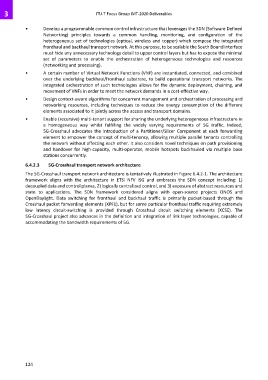Page 130 - ITU-T Focus Group IMT-2020 Deliverables
P. 130
3 ITU-T Focus Group IMT-2020 Deliverables
• Develop a programmable common control infrastructure that leverages the SDN (Software Defined
Networking) principles towards a common handling, monitoring, and configuration of the
heterogeneous set of technologies (optical, wireless and copper) which compose the integrated
fronthaul and backhaul transport network. At this purpose, to be scalable the South Bound interface
must hide any unnecessary technology detail to upper control layers but has to expose the minimal
set of parameters to enable the orchestration of heterogeneous technologies and resources
(networking and processing).
• A certain number of Virtual Network Functions (VNF) are instantiated, connected, and combined
over the underlying backhaul/fronthaul substrate, to build operational transport networks. The
integrated orchestration of such technologies allows for the dynamic deployment, chaining, and
movement of VNFs in order to meet the network demands in a cost-effective way.
• Design context-aware algorithms for concurrent management and orchestration of processing and
networking resources, including techniques to reduce the energy consumption of the different
elements associated to it jointly across the access and transport domains.
• Enable (recursive) multi-tenant support for sharing the underlying heterogeneous infrastructure in
a homogeneous way whilst fulfilling the widely varying requirements of 5G traffic. Indeed,
5G-Crosshaul advocates the introduction of a Partitioner/Slicer Component at each forwarding
element to empower the concept of multi-tenancy, allowing multiple parallel tenants controlling
the network without affecting each other. It also considers novel techniques on path provisioning
and handover for high-capacity, multi-operator, mobile hotspots backhauled via multiple base
stations concurrently.
6.4.2.3 5G-Crosshaul transport network architecture
The 5G-Crosshaul transport network architecture is tentatively illustrated in Figure 6.4.2-1. The architecture
framework aligns with the architecture in ETSI NFV ISG and embraces the SDN concept including: 1)
decoupled data and control planes, 2) logically centralized control, and 3) exposure of abstract resources and
state to applications. The SDN framework considered aligns with open-source projects ONOS and
OpenDaylight. Data switching for fronthaul and backhaul traffic is primarily packet-based through the
Crosshaul packet forwarding elements (XPFE), but for some particular fronthaul traffic requiring extremely
low latency circuit-switching is provided through Crosshaul circuit switching elements (XCSE). The
5G-Crosshaul project also advances in the definition and integration of link layer technologies, capable of
accommodating the bandwidth requirements of 5G.
124

